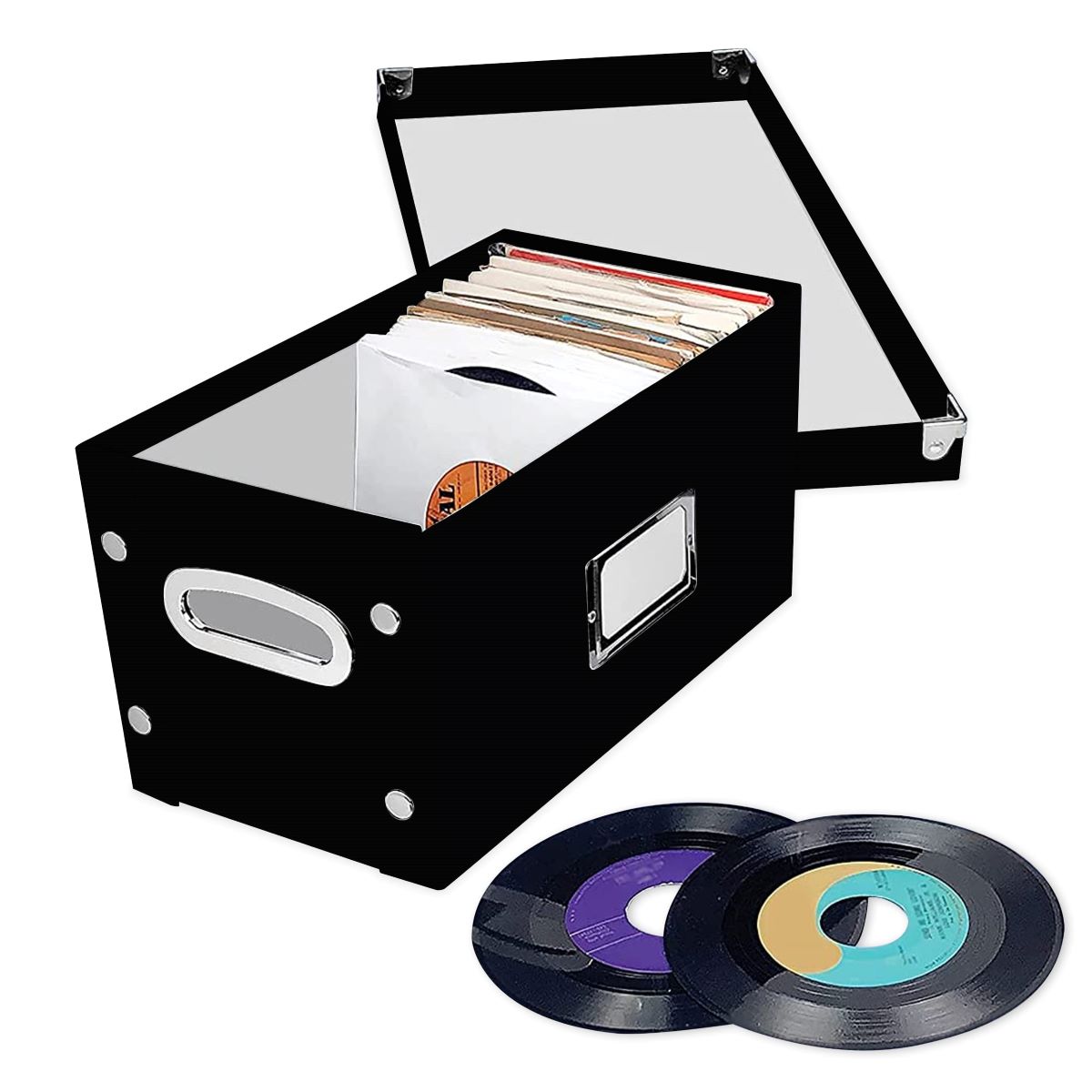

Articles
How To Store Records Properly
Modified: August 27, 2024
Learn the best practices for proper record storage. Discover the articles you need to keep your records organized and easily accessible.
(Many of the links in this article redirect to a specific reviewed product. Your purchase of these products through affiliate links helps to generate commission for Storables.com, at no extra cost. Learn more)
Introduction
Properly storing records is essential for businesses and individuals alike. In today’s digital age, where data and information are constantly being generated and accessed, having an effective and efficient records storage system is paramount. Whether it’s important documents, client information, financial records, or personal files, organizing and storing them properly ensures easy access, improves efficiency, and safeguards valuable information.
In this article, we will explore the benefits of properly storing records, factors to consider before storing records, choosing the right storage method, organizing records for easy retrieval, implementing a records management system, ensuring data security and privacy, and regularly reviewing and updating stored records.
By the end of this article, you will have a comprehensive understanding of how to store records properly and the importance of doing so. Let’s dive in!
Key Takeaways:
- Efficient retrieval, enhanced data security, compliance with regulations, streamlined workflow, and cost savings are the key benefits of properly storing records, leading to improved productivity and peace of mind.
- Consider record type, storage environment, access and security, and retention periods before choosing the right storage method. Implement a comprehensive records management system and prioritize data security and privacy to ensure efficient and compliant records storage.
Read more: How To Store Books Properly
Benefits of Properly Storing Records
Properly storing records offers numerous advantages that contribute to the smooth operation of businesses and the seamless management of personal information. Here are some key benefits:
- Efficient Retrieval:
When records are stored in a well-organized manner, it becomes much easier and quicker to retrieve information when needed. Proper indexing, categorization, and labeling allow for efficient searching and retrieval, minimizing the time and effort spent on locating specific documents. This saves valuable time and increases productivity.
- Enhanced Data Security:
Storing records properly helps protect sensitive and confidential information. By implementing appropriate security measures such as password protection, encryption, and restricted access, you can safeguard sensitive data from unauthorized access or potential data breaches. This is especially crucial when dealing with financial, legal, or personal information.
- Compliance with Regulations:
Many industries and organizations are subject to specific regulations regarding record keeping and data retention. Storing records properly ensures compliance with these regulations, which helps to avoid legal issues and potential penalties. It also allows for easier audits and inspections, as all records will be readily accessible and organized.
- Streamlined Workflow:
Proper records storage facilitates a streamlined workflow, both for individuals and businesses. With easy access to necessary information, tasks can be completed more efficiently, reducing errors and improving overall productivity. This is particularly beneficial for customer service departments, where quick access to client records is crucial for providing efficient and satisfactory service.
- Cost Savings:
Investing in proper records storage can lead to long-term cost savings. By having an organized system in place, businesses can avoid unnecessary duplication of documents and the associated costs. Additionally, digitizing and storing records digitally can significantly reduce physical storage space requirements and the expenses associated with it.
Overall, proper record storage offers a range of benefits, from improved efficiency and data security to compliance with regulations and cost savings. Organizations and individuals who prioritize storing records in a systematic and organized manner can effectively manage their information, leading to enhanced productivity and peace of mind.
Factors to Consider Before Storing Records
Before establishing a records storage system, it’s essential to consider certain factors to ensure that your storage method aligns with your needs and objectives. Here are some important factors to consider:
- Record Type and Retention Period:
Begin by classifying your records based on their type, importance, and required retention period. Different types of records have varying retention requirements, with some needing to be retained for a specific number of years for legal or compliance purposes. Understanding the specific retention periods for each record type will help you design an effective storage system.
- Storage Environment:
Consider the appropriate storage environment for your records. Factors such as temperature, humidity, and light exposure can impact the longevity and integrity of physical records. Ensure that the storage area is well-ventilated, free from excessive moisture, and protected from direct sunlight. This is particularly important for sensitive records such as photographs, delicate papers, or materials prone to damage.
- Access and Security:
Determine who needs access to the stored records and the level of security required. Certain records may contain confidential or sensitive information, necessitating restricted access. Implement appropriate security measures such as restricted access areas, locks, or digital security controls. Balancing accessibility with security is crucial to strike the right balance for your specific storage needs.
- Scanning and Digitization:
Consider digitizing physical records to enhance accessibility and reduce physical storage requirements. Scanning and digitizing records allow for easier searchability and retrieval, particularly for large volumes of data. However, it’s important to weigh the costs and benefits associated with scanning, as it may not be necessary for all types of records.
- Backup and Disaster Recovery:
Develop a backup and disaster recovery plan to protect your records from potential loss or damage. Implement a regular backup schedule and ensure that backups are stored securely in off-site locations or in cloud storage solutions. This will provide an additional layer of security and ensure business continuity in the event of unforeseen circumstances such as natural disasters or system failures.
By considering these factors, you can establish a well-designed records storage system that meets your specific requirements. This will ensure that your records are properly stored, easily accessible, and appropriately protected, allowing for efficient management and peace of mind.
Choosing the Right Storage Method
Choosing the right storage method for your records is crucial for their organization, accessibility, and long-term preservation. Here are some factors to consider when deciding on the appropriate storage method:
- Physical Storage:
Physical storage involves keeping physical copies of records in a secure and organized manner. This can include filing cabinets, shelves, or dedicated storage rooms. Physical storage is suitable for records that require original or hard copy documentation, such as legal contracts, signed agreements, or historical documents. Ensure that the physical storage area is well-maintained, with proper climate control and protection against potential hazards like fire or water damage.
- Digital Storage:
Digital storage involves storing records electronically, either on local servers or in the cloud. This method is suitable for records that can be scanned or created digitally, such as invoices, emails, or digital photographs. Digital storage offers advantages like easy searchability, quick access, and the ability to back up and protect data. However, it’s important to implement proper security measures, such as encryption and regular backups, to ensure the integrity and confidentiality of the stored records.
- Hybrid Storage:
A hybrid storage approach combines physical and digital storage methods. This approach allows for flexibility, as it caters to different types of records and storage needs. For example, you might store physical copies of legal documents while digitizing other records for easy access. Hybrid storage can offer the benefits of both physical and digital storage, allowing you to leverage the advantages of each method while minimizing any potential drawbacks.
- Off-Site Storage:
Off-site storage involves storing records at a secure, external location provided by a records management company. This option is ideal for organizations or individuals with limited space or specific security requirements. Off-site storage facilities typically offer climate-controlled environments, reinforced security measures, and professional records management services. This method helps free up office space, ensures compliance, and provides peace of mind knowing that your records are stored safely and can be easily retrieved when needed.
- Record Management Software:
Consider utilizing record management software, which provides a comprehensive solution for organizing, indexing, and retrieving records. These software platforms often have features like advanced search capabilities, metadata tagging, and version control. They can streamline the record management process, improve efficiency, and ensure consistency in records management practices.
When deciding on a storage method, consider the nature of your records, accessibility requirements, budget, and long-term preservation needs. Assessing these factors will help you choose the most suitable storage method that aligns with your specific goals and ensures the proper management and accessibility of your records.
Organizing Records for Easy Retrieval
Properly organizing your records is essential for easy retrieval and efficient management. Here are some tips to help you organize your records effectively:
- Categorize and Label:
Start by categorizing your records based on their type, function, or department. Create broad categories and subcategories that make sense for your organization or personal needs. Once categorized, label physical files or create digital folders with clear and descriptive names. Consistent and logical labeling makes it easier to locate specific records when needed.
- Create a Indexing System:
Develop an indexing system to further organize your records. Assign unique identification numbers or codes to each record, and create an index or database to track the location and content of each record. This can be as simple as an Excel spreadsheet or as advanced as a dedicated records management software. The indexing system facilitates quick and accurate retrieval, allowing you to locate records based on specific criteria.
- Use a Color-Coding System:
If you have a large volume of physical records, consider implementing a color-coding system. Assign specific colors to different categories or departments, and use colored labels or folders to visually distinguish between them. This visual cue can help expedite the retrieval process, especially when searching for records in a hurry.
- Implement Chronological Order:
For records that need to be organized chronologically, such as financial statements or meeting minutes, arrange them in date order. This can be done within each category by using dividers or separate folders for different time periods. Maintaining chronological order allows for easy tracking of historical records and simplifies the process of locating specific records from a particular timeframe.
- Regularly Weed Out Unnecessary Records:
Periodically review and weed out unnecessary records to prevent clutter and save storage space. Develop a records retention policy that outlines how long each type of record should be kept, based on legal requirements or business needs. Dispose of records that have reached their expiration date in a secure and confidential manner, ensuring compliance with data protection regulations.
- Document Changes and Updates:
If a record is updated or revised, be sure to document the changes and retain previous versions if necessary. Maintain a clear and organized system for tracking and dating revisions, ensuring that the most up-to-date version is easily identifiable. This prevents confusion and ensures that the most current information is readily accessible.
By implementing these organizational strategies, you can optimize the retrieval process and maximize efficiency when searching for specific records. A well-organized system saves time, reduces frustration, and ensures that important information is always accessible when needed.
Use acid-free and archival quality storage materials such as sleeves, folders, and boxes to protect records from deterioration. Keep them in a cool, dry, and dark environment to prevent damage from light, moisture, and temperature fluctuations.
Read more: How To Store Food Properly
Implementing a Records Management System
Implementing a records management system is crucial to effectively organize, maintain, and retrieve records. Here are key steps to help you establish a records management system:
- Assess Your Records:
Start by conducting a thorough assessment of your records. Determine the types of records you have, their volume, and their importance. This assessment helps you understand the scope of your records management needs and identify any specific requirements or compliance obligations.
- Create a Records Management Policy:
Develop a records management policy that outlines your organization’s approach to managing records. This policy should cover aspects such as record retention periods, storage guidelines, access and security protocols, and procedures for record disposal. Ensure that the policy aligns with any legal and regulatory requirements applicable to your industry.
- Designate a Records Manager:
Assign a records manager or team responsible for overseeing the implementation and maintenance of the records management system. This individual or team will be responsible for ensuring compliance with the records management policy, managing the organization, storage, retrieval, and disposal of records, and providing guidance to staff members on records management best practices.
- Establish Documented Procedures:
Create documented procedures for various aspects of the records management process. This includes procedures for record creation, indexing and labeling, storage, retrieval, and disposal. Clear and standardized procedures ensure consistency and efficiency in managing records across the organization.
- Train Staff Members:
Provide training to staff members on the records management system and procedures. Ensure that they understand the importance of proper records management, how to appropriately handle records, and their role in maintaining the integrity and security of records. Ongoing training and communication are essential to ensure all staff members are aligned with the records management policy.
- Implement Technology Solutions:
Consider utilizing record management software or other technology solutions to streamline and automate the records management process. These tools can help with indexing, tracking, and retrieval of records, as well as ensuring compliance with retention periods and security measures. Select a solution that aligns with your specific needs and budget.
- Perform Regular Audits:
Regularly conduct audits to assess the effectiveness of your records management system. This involves reviewing compliance with the policy, checking the accuracy of record indexing and labeling, and identifying any areas for improvement. These audits ensure that the system is functioning as intended and allows for adjustments or enhancements as needed.
- Maintain Security and Privacy:
Implement appropriate security measures to protect the confidentiality and integrity of records. This includes physical security measures for physical records, such as restricted access areas or locked cabinets, as well as digital security measures for electronic records, such as encryption and user access controls. Regularly review and update security protocols to mitigate any potential vulnerabilities.
By following these steps and implementing a comprehensive records management system, you can effectively organize and maintain records, ensure compliance, and enhance the overall efficiency and security of your information management processes.
Ensuring Data Security and Privacy
Data security and privacy are paramount when it comes to storing records, especially in today’s digital age. Here are key measures to help ensure the security and privacy of your records:
- Access Controls:
Implement strong access controls to restrict access to sensitive records. Assign user roles and permissions, ensuring that only authorized individuals have access to confidential information. Regularly review and update access controls to reflect personnel changes within the organization.
- Encryption:
Utilize encryption to protect sensitive information, both at rest and during transmission. Encryption ensures that even if unauthorized individuals gain access to records, the data remains unintelligible to them. Use industry-standard encryption algorithms to safeguard the confidentiality of records.
- Regular Backups:
Ensure regular backups of records to prevent data loss or corruption. Backup data should be securely stored off-site, either physically or through cloud-based solutions. Regularly test the backup and restore procedures to ensure the integrity of the backup data.
- Firewalls and Antivirus Software:
Implement robust firewalls and deploy up-to-date antivirus software to protect against unauthorized access and malware threats. Regularly update security software to ensure protection against new and emerging threats.
- Secure Disposal:
Safely dispose of records that are no longer required, ensuring that sensitive information is irretrievable. Shred physical documents prior to disposal and use secure data erasure processes for digital records. Implement a clear and documented process for record disposal to maintain compliance with data protection regulations.
- Employee Training:
Train and educate employees on data security and privacy best practices. Make sure they are aware of their responsibilities in protecting records and understand the potential risks associated with mishandling sensitive information. Regularly reinforce security protocols through training and updates.
- Monitoring and Auditing:
Regularly monitor access logs and conduct audits to identify any unauthorized access attempts or suspicious activities. Implement an auditing system that tracks and records user actions within the records management system, providing an additional layer of security and accountability.
- Compliance with Regulations:
Ensure compliance with relevant data protection and privacy regulations, such as the General Data Protection Regulation (GDPR) or industry-specific regulations. Stay up to date with changes in regulations and implement necessary measures to remain in compliance with legal requirements.
By implementing these security measures and maintaining a strong focus on data security and privacy, you can protect your records from unauthorized access, minimize the risk of data breaches, and ensure the confidentiality and integrity of sensitive information.
Regularly Reviewing and Updating Stored Records
Regularly reviewing and updating stored records is an essential practice for maintaining a well-organized and efficient records management system. Here are some key reasons why it’s important and how to go about it:
- Ensuring Accuracy and Completeness:
By periodically reviewing stored records, you can identify any inaccuracies, missing information, or outdated content. This allows you to correct errors, fill in missing details, or update records to reflect the latest information. Ensuring the accuracy and completeness of records is crucial for informed decision-making and maintaining the integrity of your data.
- Compliance with Regulations:
Regulations regarding record retention and data protection can change over time. Regularly reviewing stored records helps ensure ongoing compliance with relevant regulations. By staying informed about updates to legal or industry requirements, you can assess whether adjustments are needed in your records management practices to remain in compliance.
- Identifying Obsolete Records:
Over time, certain records may become obsolete or no longer serve a purpose for your organization. Reviewing stored records allows you to identify and weed out such records, freeing up valuable storage space and simplifying record retrieval. Removing obsolete records also reduces the risk of storing unnecessary or outdated information.
- Data Archiving and Preservation:
Some records may have long-term value or historical significance. By regularly reviewing stored records, you can identify those that should be archived or preserved for future reference. Archiving important records ensures their long-term preservation and safeguards the knowledge and history contained within them.
- Update Record Indexing and Labeling:
As records evolve or new records are added, it’s important to update the indexing and labeling system accordingly. This ensures that records can be easily located and retrieved when needed. Keeping the index and labels up to date saves time and prevents confusion in record management.
- Data Security and Privacy:
Regularly reviewing stored records allows you to assess the security of sensitive information. Identify records that contain confidential or personally identifiable information, ensuring that proper security measures are in place to protect them from unauthorized access. This helps maintain the privacy and confidentiality of sensitive data.
- Implementing Retention and Disposal:
Reviewing stored records allows you to adhere to your defined records retention and disposal policy. Determine which records have reached their required retention period and dispose of them securely and in accordance with relevant regulations. This not only helps maintain compliance but also frees up storage space and streamlines record management.
Regularly reviewing and updating stored records is crucial for maintaining an efficient and organized records management system. By ensuring accuracy, compliance, and the relevant retention and disposal of records, you can optimize your records management process, improve decision-making, and minimize potential risks associated with outdated or unnecessary information.
Conclusion
Properly storing records is essential for businesses and individuals alike. By implementing effective records storage methods, organizing records for easy retrieval, and maintaining data security and privacy, you can enhance efficiency, ensure compliance, and preserve valuable information.
The benefits of properly storing records are far-reaching. Efficient retrieval saves time and boosts productivity, while enhanced data security safeguards sensitive information. Compliance with regulations prevents legal issues and penalties, and streamlined workflows lead to better customer service. Additionally, cost savings can be achieved by eliminating unnecessary duplication and reducing physical storage space requirements.
Before storing records, consider factors such as record type, retention periods, storage environment, and access and security needs. Choose the storage method that aligns with your requirements, whether it be physical, digital, hybrid, or off-site storage. Implement a proper records management system, including policies, procedures, and training for employees.
Ensure data security and privacy by implementing access controls, encryption, regular backups, firewalls, and antivirus software. Properly disposing of records and regularly reviewing and updating them prevents clutter, maintains compliance, and optimizes the management process.
In conclusion, by paying attention to proper records storage, organization, security, and regular reviewing and updating, you can effectively manage important records, improve efficiency, protect sensitive information, and comply with legal and regulatory requirements. Investing time and effort into implementing these practices will yield long-term benefits, providing a solid foundation for effective information management and decision-making.
Frequently Asked Questions about How To Store Records Properly
Was this page helpful?
At Storables.com, we guarantee accurate and reliable information. Our content, validated by Expert Board Contributors, is crafted following stringent Editorial Policies. We're committed to providing you with well-researched, expert-backed insights for all your informational needs.















0 thoughts on “How To Store Records Properly”